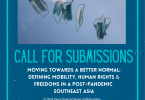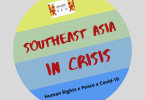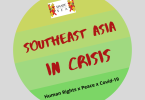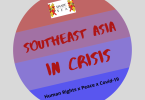Stephen Nyein Han TunLand Researcher and Customary Land Tenure Associate Coordinator
 Myanmar, formerly known as Burma, is a Southeast Asian country, which is home to 135 diverse culture and language groups (Bianco, 2016) living together under a centralized government. Located along Mekong and Irrawaddy basins, it has also been tagged as a state shaped largely by civil war (Stokke, Vakulchuk and Øverland, 2018). This primarily is due to decades-long conflicts between the government and various ethnic/indigenous armed groups (Kramer, 2005). Most indigenous lands are located along the edges of the country, while most Burmese people live mainly in low-land areas (Kramer, 2015). Historically, indigenous peoples’ rights to customary land/tenure in Myanmar have been ignored by both the military and civilian-led government. Moreover, the Constitution does not recognize such rights.
Myanmar, formerly known as Burma, is a Southeast Asian country, which is home to 135 diverse culture and language groups (Bianco, 2016) living together under a centralized government. Located along Mekong and Irrawaddy basins, it has also been tagged as a state shaped largely by civil war (Stokke, Vakulchuk and Øverland, 2018). This primarily is due to decades-long conflicts between the government and various ethnic/indigenous armed groups (Kramer, 2005). Most indigenous lands are located along the edges of the country, while most Burmese people live mainly in low-land areas (Kramer, 2015). Historically, indigenous peoples’ rights to customary land/tenure in Myanmar have been ignored by both the military and civilian-led government. Moreover, the Constitution does not recognize such rights.
While the world continues to battle with Covid-19, indigenous peoples in Myanmar, particularly in Shan State, have been facing compounded threats brought about by the health crisis and armed conflicts, such as lack of access to medical services, reliefs, health education. Furthermore, their customary lands are being confiscated by the State to give way for mega infrastructure concessions and large-scale land-based investments. In short, they have been denied of rights to access, withdraw, control, claim, profit, use, exclude, lease, and manage their customary land (Allaverdian, Forgerite, Scurrah and Si Thu Htike San, 2017). Food and livelihood insecurities have been aggravated by the inability to freely cultivate crops on their lands. Furthermore, farmers are not given the opportunity to access legal assistance.
On 30 March 2020, when infections were starting to get recorded in the country, the Central State permitted 1,229 mining concession projects in different regions. Around 326 concessions of these types are found in Shan State (Ministry of Resource and Natural Environmental Conservation Department, 2020). Mining capitalists have been keen to take advantage of Namatu Bawdwin mine and other places in Shan State while disregarding the rights of indigenous peoples. On 30 May 2020, Sai Wan Sai (2020) points out that a land dispute broke between the Pa ™O indigenous people and Tatmadaw. The Tatmadaw confiscated around 900 acres of land of the indigenous in 2018. When the Pa ™O farmers who protested were eventually arrested and sent to jail (Sai Wan Sai, 2020).
The China-Myanmar Economic Corridor (CMEC), a part of China’s One Belt One Road Initiative (BRI), has been accelerated by political, social, and economic changes in Myanmar. This acceleration has also been compounded by amendments to land-use policies’ mechanism as a form of State legal land dispossession politics. These policies appear in the 2008 Constitution’s basic national land regulation, 1894 Legal Land Acquisition Act of 2012 (the rights of State in land use and management), the Grants and Leases of Land at the Disposal of Government Policy in 2016 National Land Use Policy, and the 2012/2016 and 2019 Vacant-Fallow-Virgin (VFV) Land laws. Capital accumulation by the CMEC for global energy markets has threatened the customary land (tenure) and the livelihood (including women’s lives) of the Ta ™ang indigenous tea farming society (Nyein Han Tun, 2019).
The National Land Use Policy of 2016 mandates the Government to recognize and protect customary land tenure rights and procedures (National Land Use Policy, 2016). UNDRIF Article 10 also points out that the “Indigenous peoples shall not be forcibly removed from their land or territories. No relocation shall take place without the free, prior and informed consent of the indigenous peoples concerned and after agreement on just and fair compensation and, where possible, with the option return.” However, amid the Covid-19 pandemic, the current civilian government has been adamant to strengthen economic development through land and water-based investments such as seaport, Special Economic Zones, large-scale agribusinesses, highway roads, and different kinds of infrastructure development. These position and perspective prove that it is unable and unwilling to respect and protect the right of its indigenous peoples to live in dignity.
Reference:
Allaverdian, C., Julia Forgerite, Natalia Scurrah and Si Thu Htike San. (2017). Documenting Customary Tenure in Myanmar. A Guidebook. MRLG guidebook #1. Vientiane & Yangon: Mekong Region Land Governance.
Bianco, Joseph Lo. (2016). Building a National Language Policy for Myanmar: An Investment in National Development, Peace, Social Progress and Improved Education. The University of Melbourne Press.
Clements, Alan and Leslie Kean. (1995). Burma ™s Revolution of the Spirit: The Struggle for Democratic Freedom and Dignity. Bangkok: White Orchid Press.
Department of Population. (2017). Census Atlas Myanmar: The 2014 Myanmar Population and Housing Census. Ministry of Labour, Immigration and Population, May Pyi Taw, Myanmar.
Dittmer, Lowell. (2010). Chapter 1 Burma vs. Myanmar, what ™s in a name? , in Lowell Dittmer (ed.) Burma or Myanmar? The Struggle for National Identity (pp. 1-20). Singapore: World Scientific Publisher.
Food and Agriculture Organization of the United Nations. (2002). Land Tenure and Rural Development. FAO Land Tenure Studies. Rome, FAO.
Ganesan, Narayanan and Kyaw Yin Hliang (eds.). (2007). Myanmar State, Society and Ethnicity. Singapore: Institute of Southeast Asian Studies Publishing.
Kramer, Tom. (2005). Ethnic Conflict and Dilemmas for International Engagement in Jelsma et al. (eds.). Trouble in the Triangle: Opium and Conflict in Burma. Silkworm Books.
Kramer, Tom. (2015). Ethnic Conflicts and Land Rights in Myanmar. Social Research 82 (2): 355-374.
National Land Use Policy. (2016). The Republic of the Union of Myanmar: National Land Use Policy. Retrieved from http://extwprlegs1.fao.org/docs/pdf/mya152783.pdf
Nyein Han Tun. (2019). Ta ™ang Tea Farmers and Customary Land Dispossession in the Context of China-Myanmar Economic Corridor in Northeast Myanmar. Master of Arts in Social Science (Development Studies) Thesis. Chiang Mai University, Northern Thailand.
Ministry of Resource and Natural Environmental Conservation Department. (2020). Retrieved from http://www.mining.gov.mm/News_mm/default.asp?page=1
Sai Wansai. (2020). Military Land Confiscation: Major obstacle for ethnic traditional land ownership. Retrieved from https://www.bnionline.net/en/news/military-land-confiscation-major-obstacle-ethnic-traditional-land-ownership
Stokke, Kristian, Roman Vakulchuk and Indra Øverland. (2018). Myanmar: A Political Economy Analysis. Norwegian Institute of International Affairs.





